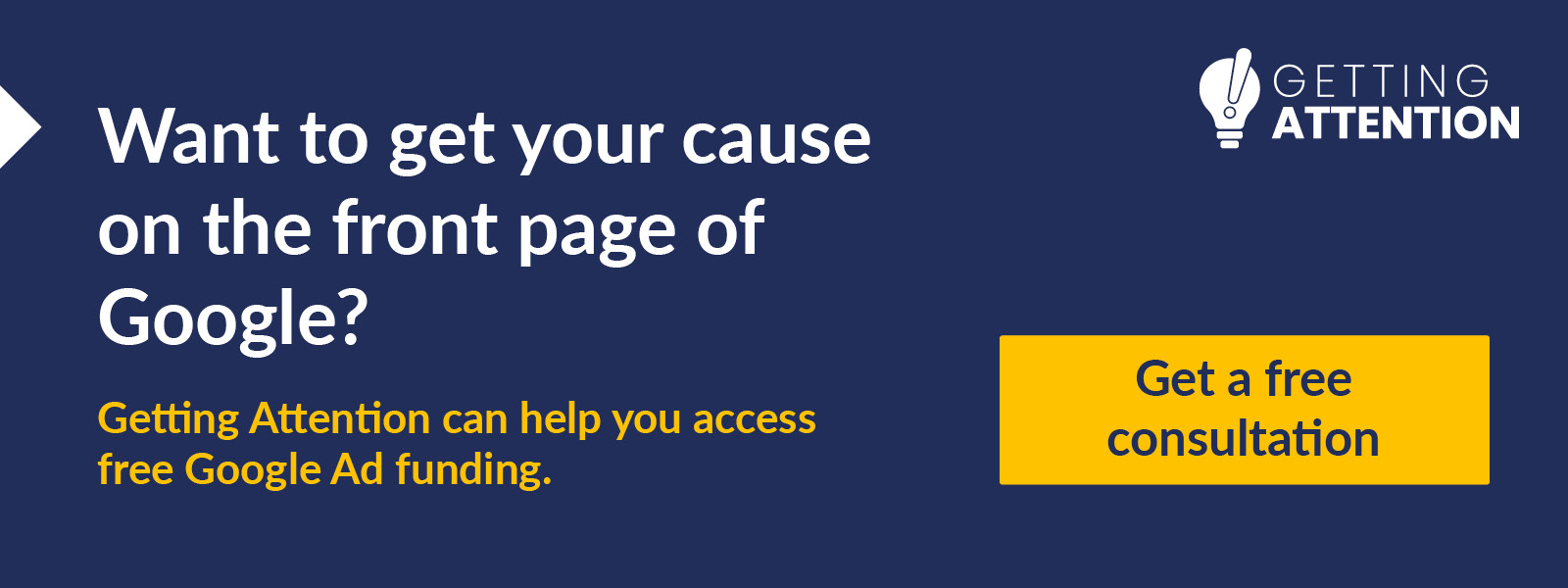Nonprofit Awareness Campaigns Guide: Steps, Tips, & Examples
Does your organization need to get the word out about an urgent funding need? Are you looking to boost public understanding about an issue in your community? A nonprofit awareness campaign can quickly put your cause in the spotlight!
These marketing campaigns primarily focus on educating people about your work, and they can be facilitated through traditional media channels or run entirely online.
To help you get started with your own nonprofit awareness campaign, this guide will cover everything you need to know to be successful:
- Nonprofit Awareness Campaigns FAQ
- Launching a Nonprofit Social Awareness Campaign: 7 Steps
- Tips for a Successful Awareness Campaign Strategy
- Top Nonprofit Awareness Campaign Examples
If you’re ready to spread the word about a cause that’s close to your heart, an awareness campaign is likely the best move. Let’s dive in!
Nonprofit Awareness Campaigns FAQ
Before we cover the process of hosting your own nonprofit awareness campaigns, here are some basics you should know.
What are nonprofit awareness campaigns?
Nonprofit awareness campaigns, also known as social awareness campaigns or public awareness campaigns, are marketing initiatives that aim to increase public knowledge of or interest in a cause.
These causes are directly related to your nonprofit’s mission, but they typically concern a specific issue rather than your organization’s entire purpose. Consider these examples:
- A legal aid organization wants its constituents to be aware of a new immigration law and its potential implications. It spreads the word in email newsletters and blog posts.
- An animal shelter wants to raise awareness about the importance of adopting rather than purchasing from backyard breeders. It sells a collection of branded merchandise that features the main message of the campaign: “Save a Life! Adopt! Don’t Shop.” This way, the organization’s supporters can help raise awareness just by using the products they buy.
- A disaster relief organization runs a rapid-response awareness campaign in preparation for the upcoming hurricane season. Using radio and social media ads, it informs the community about emergency preparedness best practices and available resources.
When are the best times to launch nonprofit awareness campaigns?
This depends on your nonprofit. Many organizations find that the best time to host their campaign is in conjunction with an established day of nonprofit fundraising or awareness month, such as GivingTuesday or AAPI Heritage Month. During these months, your audience may be extra interested in your cause, and an awareness campaign can help your nonprofit stand out.
Ultimately, the best time to launch a nonprofit awareness campaign is the time that makes the most sense for your organization and your target audience.
Where do you promote nonprofit awareness campaigns?
Just like any other nonprofit marketing campaign, you should choose communication channels that align with your audience’s preferences. Social awareness campaigns see a lot of success online, but plenty of campaigns combine both digital and in-person elements.
Common places to promote nonprofit awareness campaigns include:
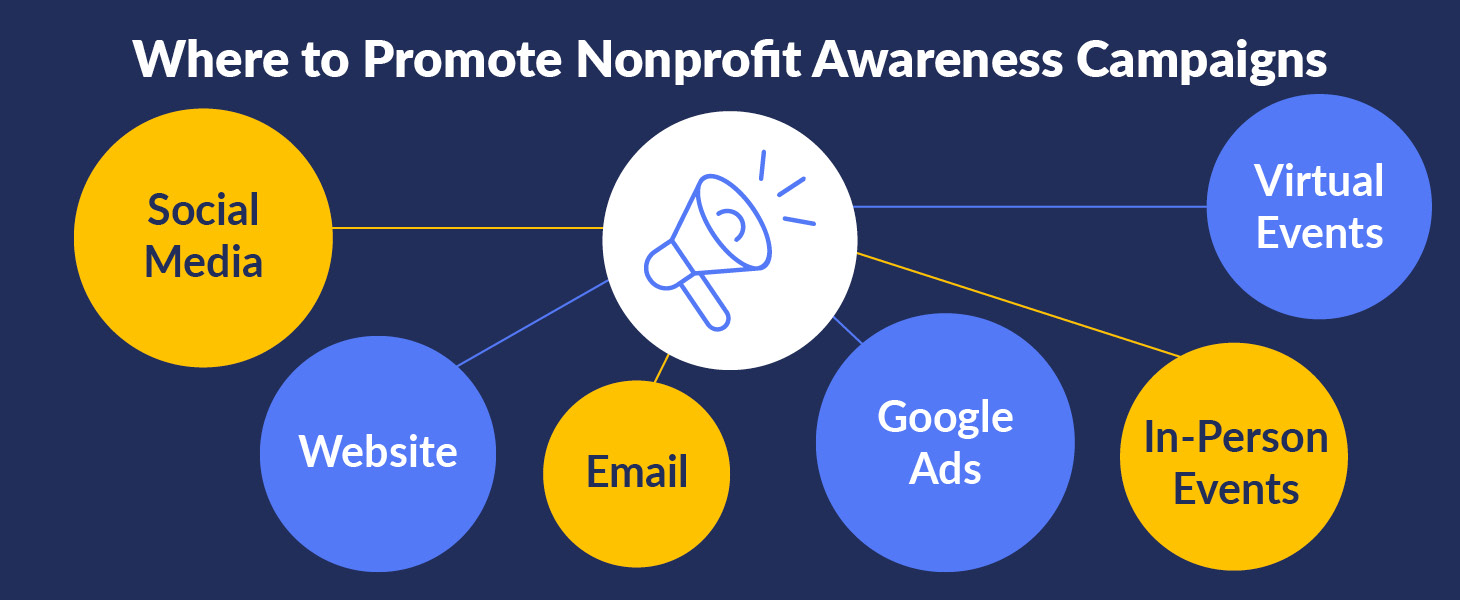
- Social media
- Your website
- Google Ads
- In-person events
- Virtual events
Look at the communication preference information in your donor database along with past results of marketing campaigns to determine the right channels for your nonprofit.
What tools and resources help nonprofits spread their awareness campaigns?
Since many nonprofits host awareness campaigns, there’s plenty of available support for organizations that want extra help. Consider using:
- Marketing platforms: Since you’ll likely use multiple marketing channels during your awareness campaign, you may find it tricky to give each channel the time and attention it needs to be an asset to your campaign. Using a marketing platform such as an email marketing tool or a social media management solution can help organize your outreach efforts and even automate menial tasks for you, such as creating HTML code for your email newsletters.
- Fundraising platforms: If your awareness campaign includes a fundraising component, consider leveraging a fundraising platform to facilitate giving. For example, you may set up a crowdfunding page, launch a peer-to-peer fundraiser, or sell products to help raise money for your cause. Ensure any platform you use can securely process donors’ payments.
- Metric tracking tools: To track progress toward your awareness-raising goals, you’ll need data. Leverage new or existing tools to get the data you need. For example, you might choose Google Analytics to track trends in visitor behavior on your website to evaluate how well it’s helping with your campaign.
One of the best resources available for awareness campaigns is the Google Ad Grant. As part of their corporate social responsibility program, Google offers grants of $10,000 in free monthly ad credits to nonprofits.
This is an invaluable resource for getting your awareness campaign in front of the right audience, as you’ll gain access to users searching for terms relevant to your campaign—meaning they already have an interest in your cause. Plus, they’re proven to be effective. According to Double the Donation’s fundraising statistics, search ads like Google Ads have the highest return on investment of any nonprofit advertising method.
On top of that, reach out to expert consultants who can help you make the most of your Google Ad Grant. They’ll work with you to discuss your campaign goals and messaging strategy. Then, they’ll help create ads that grab your audience’s attention.
Do nonprofit awareness campaigns work?
When run strategically, nonprofit awareness campaigns can result in increased brand awareness, better fundraising performance, and more online visibility for your cause. Just take a look at the data:
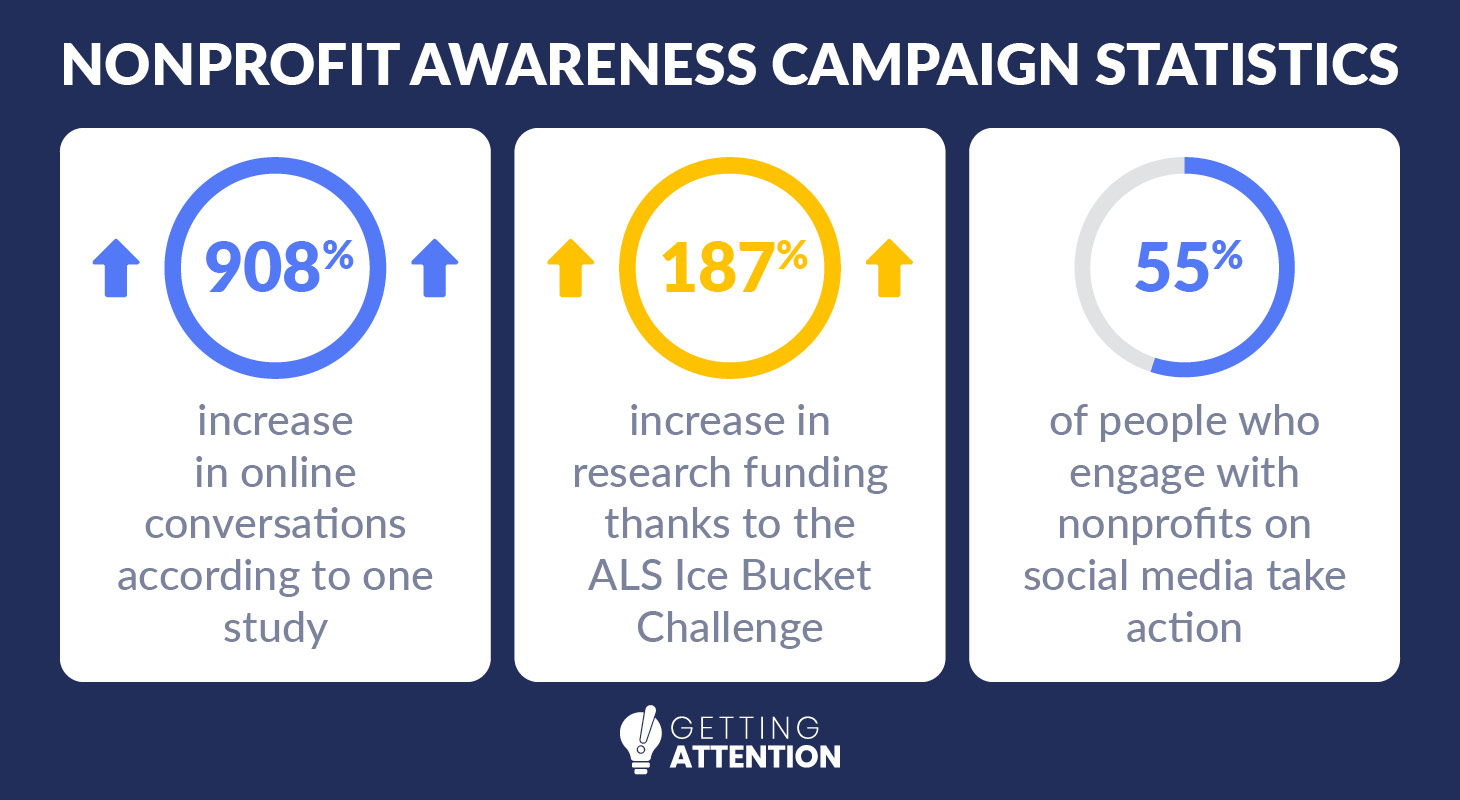
- One case study found that an awareness campaign increased online conversations about the nonprofit’s cause by 908%.
- The most well-known awareness campaign, the ALS Ice Bucket Challenge, raised enough funds to increase ALS research funding by 187%.
- Overall, 55% of those who engage with nonprofits on social media take action. This means that running your awareness campaign on social media can generate plenty of conversions toward your cause. Clearly, social awareness campaigns can be highly successful for nonprofits. But like any campaign, that success can vary depending on the strategies you use.
Clearly, social awareness campaigns can be highly successful for nonprofits. But like any campaign, that success can vary depending on the strategies you use.
Tips for a Successful Awareness Campaign Strategy
To craft the most compelling ads and develop an effective awareness campaign strategy, follow these expert tips:
Use storytelling techniques to evoke emotion
Since awareness campaigns are all about generating public interest in a cause or issue, it’s crucial that your messages make an emotional connection with your audience. The best way to do that is by using stories.
Use these nonprofit storytelling techniques as a foundation for your campaign ads:
- Focus on a central character or group of characters.
- With their permission, share real stories of your beneficiaries’ experiences.
- Focus on the stories of beneficiaries and donors rather than your nonprofit’s story.
- Include concrete details like names, numbers, and statistics.
As you tell these stories, avoid evoking negative emotions like fear or guilt in your awareness ads. Uplifting stories are much more likely to prompt genuine empathy and action from audience members than scare tactics.
Provide clear calls to action
Most nonprofit awareness campaigns aren’t only about spreading awareness of an issue. Rather, they encourage supporters to take action immediately to support that cause. Even if the only action you want supporters to take is to share information, you need to let them know that!
Do this by including clear, compelling calls to action (CTAs) in your messages. Tell readers exactly what they need to do to help and how to do it. Make it as easy as possible to share a post, donate, or join your mailing list by providing directions and links.
Take a look at the CTA in this Instagram post from Color of Change:
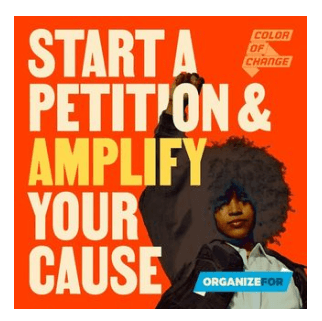
In large, bold font, Color of Change calls on its supporters to start a petition to improve Black lives in their own communities. They don’t stop at “Start a Petition,” either. By telling supporters to “Start a Petition & Amplify Your Cause,” this post assures supporters that their action will have a clear and powerful impact on Color of Change’s mission.
Don’t be afraid to branch out
Social awareness campaigns are often the perfect time to get creative with your strategy. Don’t feel boxed in by your typical communication channels or your traditional marketing approaches. Some of the best nonprofit awareness campaigns are the ones that take their audience by surprise.
Consider branching out with your strategy by incorporating:
- Social media challenges
- Non-traditional communication channels like TikTok
- Google search ads
- Peer-to-peer ambassadors
- Collaborations with other organizations
That being said, keep your audience in mind when choosing how to get creative. If you know that your target audience doesn’t use TikTok, for example, move in a different direction.
Launching a Nonprofit Social Awareness Campaign: 7 Steps
Now that you know the fundamentals, let’s explore the process of hosting your own nonprofit awareness campaigns.
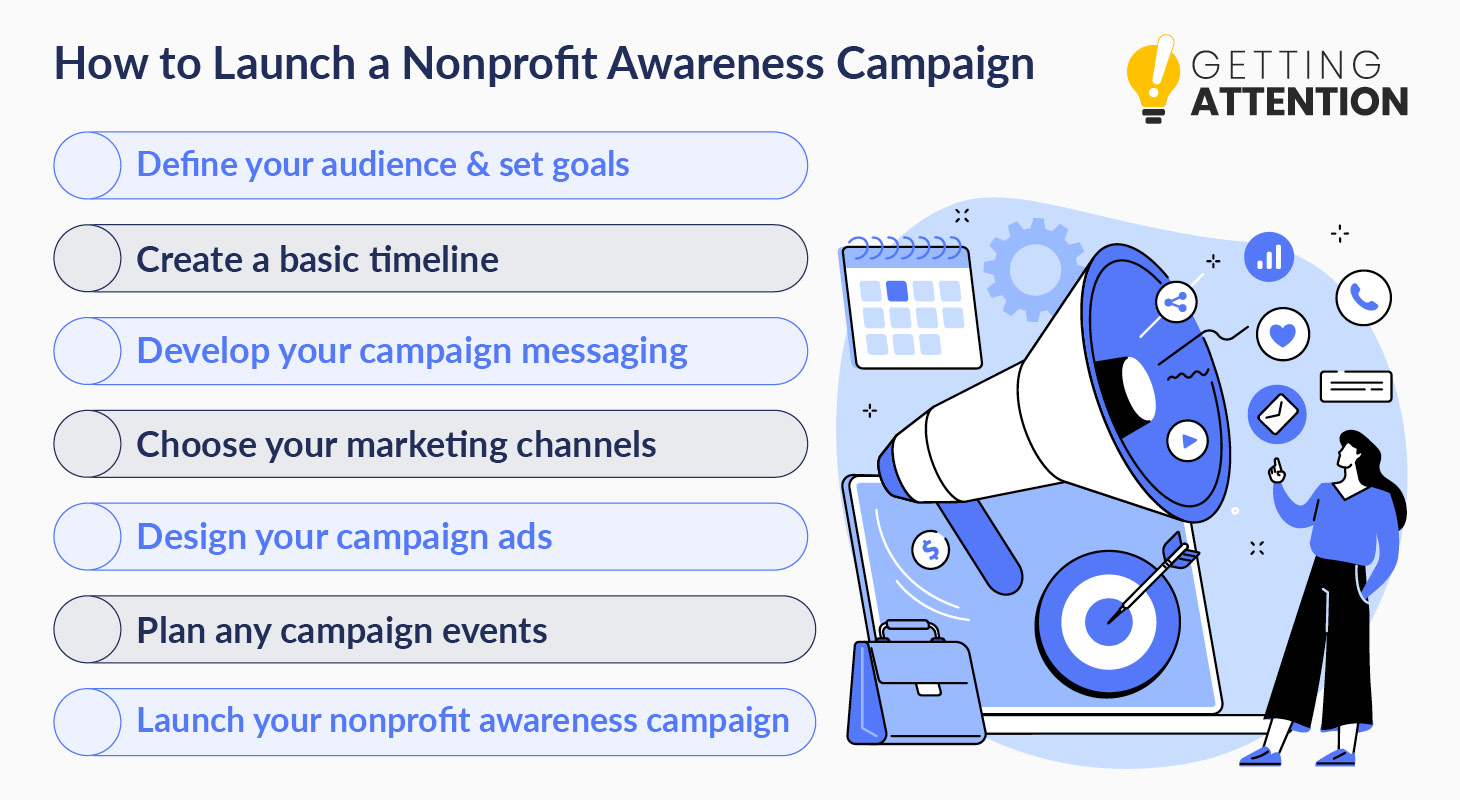
1. Define your audience & set goals
Determining your audience and setting goals go hand in hand. Think about the purpose of your awareness campaign. Do you want to bring a new issue to the forefront of your supporters’ minds? Or do you aim to generate widespread awareness for a specific cause your nonprofit currently prioritizes, acquiring new donors in the process?
Once you’ve broadly determined your main goal and who your target audience is, take stock of their interests and communication habits. Then, use this information to guide your campaign’s messaging, communication channels, and event strategy.
Don’t forget to set key performance indicators (KPIs) so you can measure your progress. If your goal is to raise a certain amount of money using a unique fundraising idea, for example, your KPIs might be the total dollar amount raised and the cost per dollar raised (CPDR). Monitor these metrics throughout your campaign to see how successful your organization was and find opportunities for improvement.
2. Create a basic timeline
Like we mentioned earlier, many nonprofits choose to align their social awareness campaigns with established national awareness months or days. This helps drive support for your campaign because the public will already be thinking about your cause. However, there are also plenty of successful nonprofit awareness campaigns that run on their own timeline!
Once you’ve considered your options, make the following decisions about the timeline of your campaign:
- If your campaign will be aligned with a national observance
- If the campaign will lead up to a single day, like GivingTuesday
- How long the campaign will last
- How much planning time your team will need
With these decisions made, you’ll be able to create a basic timeline for your campaign and schedule major dates. As you go through the next steps, you can refer back to this timeline and fill it in with more detail to turn it into a thorough marketing plan.
3. Develop your campaign messaging
To develop a strong and cohesive campaign message, reflect on your mission and the themes of any national months or awareness days you’re participating in:
- If you decide to align your campaign with a national month, such as Black History Month or Breast Cancer Awareness Month, ground your messaging in the themes, subjects, images, and colors associated with the month. This will cause the public to connect your marketing materials with causes and ideas they’re already familiar with, increasing comprehension
- If your campaign doesn’t align with a specific observance day or month, try to focus on a specific cause your nonprofit supports rather than your entire mission. Consider issues that are especially urgent or relevant right now. Then, determine how you’ll talk about them in your campaign.
Choose one overarching message for your campaign that supports your goals, resonates with your audience, and aligns with any existing public associations or opinions. Use this message as the foundation for every advertisement or piece of campaign merchandise you create to maintain consistency.
In the ad example below, you can see how Wear Orange aligned its nonprofit awareness campaign with National Gun Violence Awareness Month and focused its messaging on how many Americans are affected by gun violence. Keeping their target audience in mind, Wear Orange created graphics in both English and Spanish:
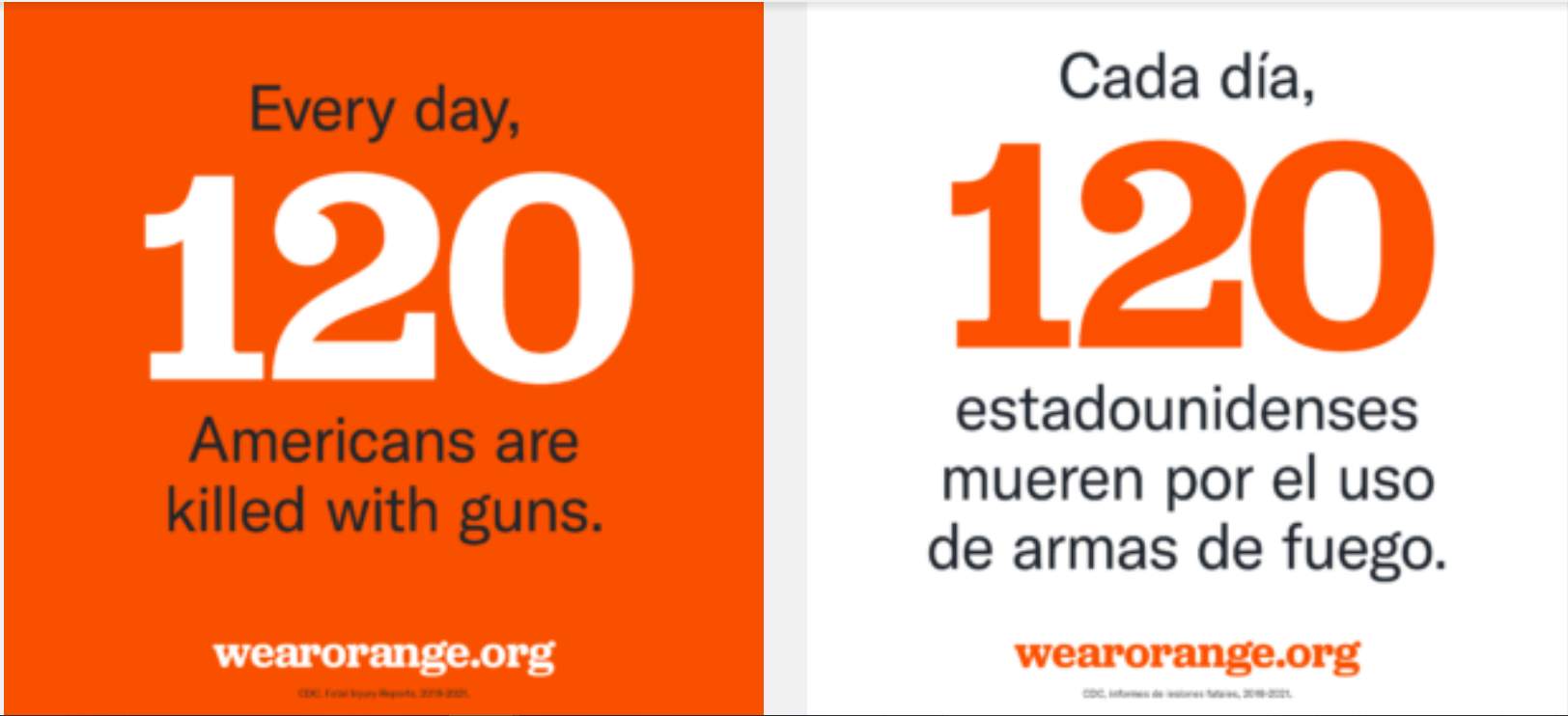
4. Choose your marketing channels
The communication channels you use to advertise your social awareness campaign will be vital for its success. Use your donor data and additional research to determine which channels your audience is most active on, then choose a combination of digital and traditional channels to focus on. These might include:
- Your website
- Google Ads
- Direct mail
- TikTok
You can also think outside the box when it comes to your marketing channels. For instance, say you create and sell t-shirts with your organization’s name or slogan on them as part of your campaign. You can encourage everyone who purchases a shirt to wear on a certain date to engage in a unique form of outreach!
5. Design your campaign ads
Once you have your communication channels set in stone, you can begin designing your campaign ads. Refer back to your overall campaign message, then use these tips to design your most important marketing materials:
- Campaign page: Create a balance of visuals, information, and calls to action on your campaign page. Provide all the resources supporters need to take part in the awareness campaign, such as instructions for peer-to-peer fundraising, but don’t forget to tell your story with compelling visuals, too.
- Social media posts: Design a set of social media graphics and videos that match the strengths of your chosen platforms. Powerful posts often include surprising statistics or quick breakdowns of actions supporters can take.
- Google Ads: With the Google Ad Grant, your nonprofit can reach brand new audiences who are already searching for terms related to your awareness campaign. Design these ads with new audiences in mind, and don’t be afraid to seek the help of Google Ad Grant professionals.
Remember to maintain consistency throughout all of your advertisements in terms of colors, logos, and tone. Aligning all posts with your branding will ensure that your audience can immediately tell that these messages belong to your organization and to the same campaign.
6. Plan any campaign events
Not all nonprofit awareness campaigns include events, but many organizations choose to host them as a way to build community with donors or celebrate the progress of the campaign.
If you do decide to host a campaign event, determine if it should be a kickoff or conclusion event and if your audience would prefer the event to be in person, hybrid, or virtual. Then, start planning logistics. Don’t forget to budget for things like software costs and tech support if you’re hosting an online event or venue rentals for in-person events.
7. Launch your nonprofit awareness campaign
With your planning done, it’s time to launch the campaign! Follow your timeline for sending out messages on whatever channels you’ve selected for the campaign. Proactively connect with the people who engage with your campaign. For instance, promptly respond to social media comments and messages or questions that come in via phone or email.
Throughout the campaign, continue tracking the metrics that show your progress toward campaign goals. This will allow you to course-correct as needed if you’re not headed toward the results you want to see.
Once the campaign is over, don’t forget to thank everyone involved—every donor, volunteer, and influencer who helped drive awareness for your nonprofit’s cause. Here are some best practices for doing so:
- Thank supporters quickly. The sooner you demonstrate appreciation, the sooner a supporter will feel seen and valued by your organization. For donors, you can easily set up an automated thank-you email that triggers after a donation is given.
- Personalize your thank-you messages. Awareness campaigns can and should help you strengthen relationships with people who care about your cause. Personalize thank-you messages by including donors’ names and specifying what action they completed that helped your campaign succeed.
- Ensure your thank you fits the recipient’s level of involvement. A gift basket full of treats from local businesses and branded merchandise from your organization might be appropriate for a major donor or heavily involved volunteer, while a thank-you email suffices for those who give smaller donations.
- Invite further involvement. Educate your supporters about how they can support your mission during the campaign and after it ends. For donors, avoid overwhelming them by immediately issuing another donation request. Instead, highlight volunteer opportunities or upcoming events they can attend.
Don’t forget to have fun with your appreciation strategies! Consider unique methods like sending an eCard, highlighting supporters’ impact on your website, creating a donor appreciation video, or throwing a volunteer appreciation event. Doing something out of the ordinary will make your campaign memorable for everyone involved.
Top Nonprofit Awareness Campaign Examples
Plenty of nonprofits have been in your shoes and found success. Get inspired by these popular nonprofit awareness campaigns:
ALS Ice Bucket Challenge
When you think of social awareness campaigns, the Ice Bucket Challenge is likely the first one that comes to mind. This 2014 online challenge rapidly became an international phenomenon, getting celebrities, families, and people everywhere to dump buckets of ice water on their heads in support of a cure for ALS. It’s known as a form of hashtag activism because of how it spread awareness and inspired action.
By advertising the unique challenge on Facebook, Twitter, and their website, the ALS Association was able to raise $115 million from 2.5 million donors. Years later, the funds raised as a result of this awareness campaign have led to dramatic progress in ALS research.
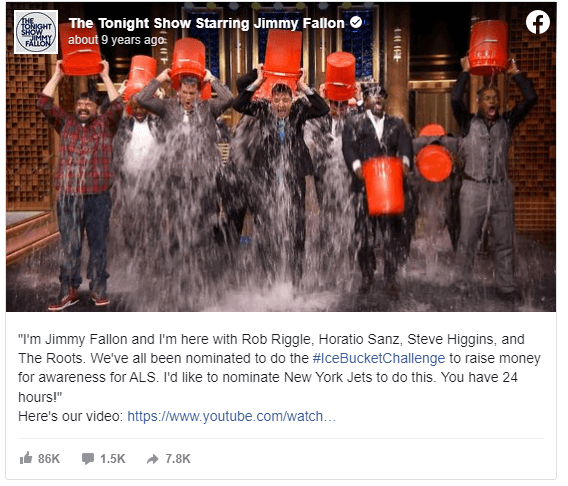
What made this nonprofit awareness campaign successful:
- By using the format of a social media challenge, word of the ALS Association’s cause quickly spread from one supporter to their entire social network.
- The Ice Bucket Challenge relied on celebrity influencers who provided the ALS Association with access to a much wider audience.
- The directions for participating in the campaign were straightforward and simple, making it easy for anyone to join.
988 Suicide & Crisis Lifeline’s “I’m So Glad You’re Alive” Call 988 T-Shirt Fundraiser
988 Suicide & Crisis Lifeline is a national network of local crisis centers that provides free and confidential emotional support to people in suicidal crisis or emotional stress on a 24/7 basis.
In 2022, the organization launched a t-shirt fundraiser through Bonfire to raise awareness about the new Lifeline phone number available to the public, 988. Proceeds from the fundraiser went toward all activities associated with running Lifeline.

What made this nonprofit awareness campaign successful:
- The “I’m So Glad You’re Alive” Call 988 Campaign took place ahead of the launch of the new Lifeline phone number, helping educate the public about a new mental health resource.
- By using a fundraising platform like Bonfire, the organization made it simple and easy for supporters to give to their cause and get something (a high-quality t-shirt) in return.
- Selling t-shirts not only provided a way for supporters of the 988 Suicide & Crisis Lifeline to make an impact on the organization but also to raise awareness in their personal networks about suicide prevention. Every time a t-shirt buyer wears their shirt, they’re advertising the new Lifeline.
Wear Orange for Gun Violence Awareness
Every year since 2013, Wear Orange has hosted a national awareness campaign for victims of gun violence. The campaign asks supporters to draw attention to the issue of gun violence with one simple action: wearing orange.
During the first weekend in June, Wear Orange hosts in-person events across the country in collaboration with local nonprofits. They also promote the campaign on social media, providing supporters with multilingual graphics and information to share on their own pages.
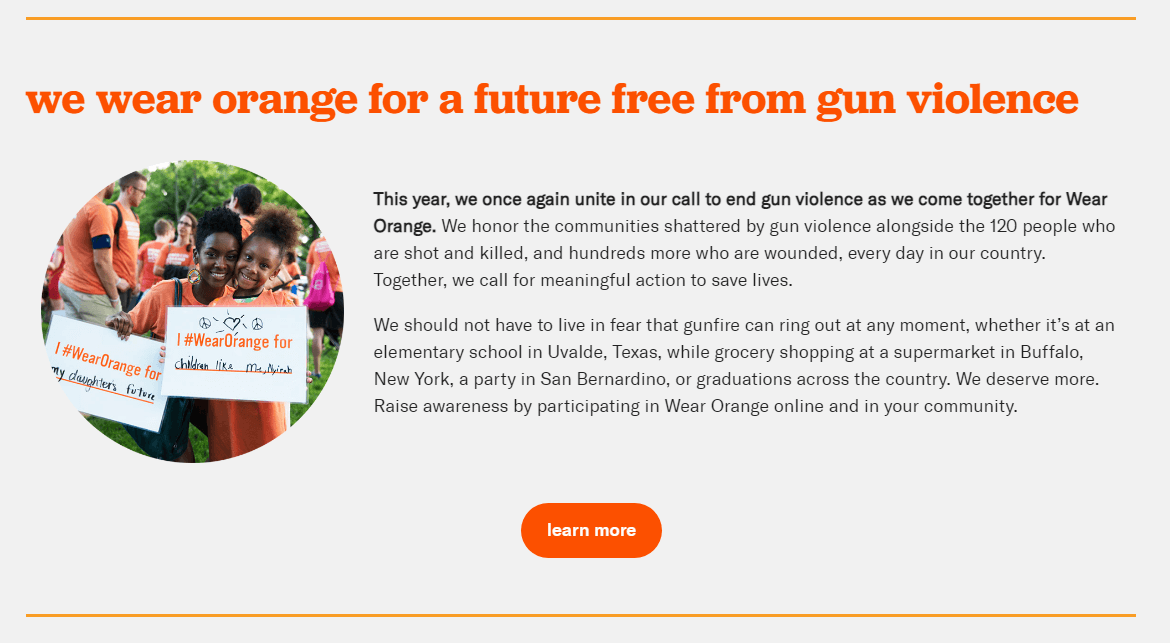
What made this nonprofit awareness campaign successful:
- Wear Orange hosts its annual awareness campaign in June, which is National Gun Violence Awareness Month.
- The campaign website features a “ways to participate” page, which gives clear, straightforward directions on how to take action.
- In 2018, Wear Orange centered its campaign messaging around a single story: the shooting of Hadiya Pendleton and how her friends commemorated her by wearing orange.
Neuroclastic, Inc.’s Bonfire Peer-to-Peer Fundraising Page
Neuroclastic, Inc. is a nonprofit publication headquartered in Lynchburg, Virginia. It features resources, articles, and creative expressions from Autistic people about the autism spectrum.
Neuroclastic, Inc. has its own profile and merch store on the t-shirt fundraising platform Bonfire that features their custom t-shirt designs and allows supporters to sell t-shirts on behalf of the organization’s cause.
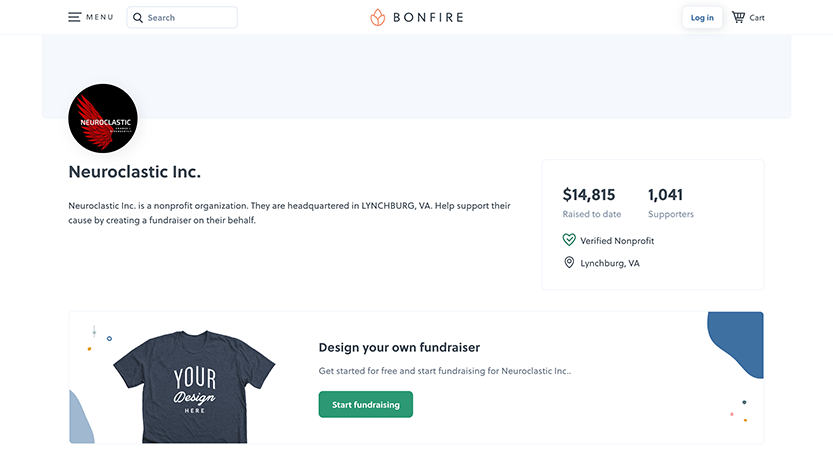
What made this nonprofit awareness campaign successful:
- The opportunity to start a peer-to-peer fundraiser for Neuroclastic, Inc. is an ongoing one. This means supporters can easily jump into action when the time is right for them.
- The variety of designs offered on Neuroclastic, Inc.’s online t-shirt store provides several fun options for supporters to choose from when they want to contribute to the organization’s mission.
- The organization practices what it preaches—its All Autistic Communication Is Valid design was created by an Autistic illustrator. This demonstrates that the nonprofit truly empowers Autistic people.
Wrapping Up
When done well, nonprofit awareness campaigns can quickly bring your community together to learn about and support your organization’s cause. They can lead to plenty of new donors and turn your existing supporters into true advocates for your nonprofit.
Planning a nonprofit awareness campaign takes work, but you don’t have to do it alone. Consultants like the experts at Getting Attention are here to help you design compelling ads and run an impactful awareness campaign. To learn more, check out these additional resources:
- Nonprofit Advertising: The Essential Guide (With Examples!). Stuck on designing your ads? Use these tips and tricks to make your awareness campaign advertisements stand out.
- Impact Report: The Power of the Google Ad Grant. Read our report on the wide-reaching impact of Google Ads to see how they can boost your nonprofit awareness campaigns.
- How to Apply for Google Grants: 5 Easy Steps for Nonprofits. Applying for free advertising credits from the Google Ad Grant is easy with these 5 simple steps.
- 40 Nonprofit Fundraising Event Ideas Communities Will Love. An event can complement your nonprofit’s awareness campaign. Get fun and fresh event ideas in this guide from Bonfire!




